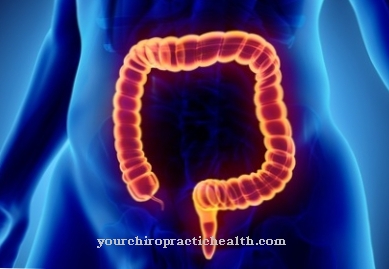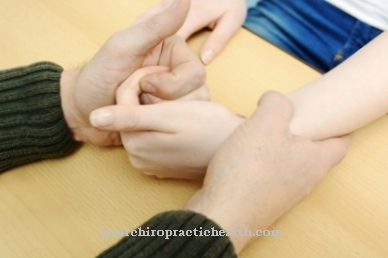The Smear infection is a possible transmission path for various infectious diseases through contact with contaminated surfaces. Colds and gastrointestinal infections in particular are transmitted by smear infection.
What is a smear infection?

From one Smear infection we speak when germs are indirectly transmitted from one person to another via contaminated surfaces or food.
In contrast to droplet infection, the germ carrier no longer has to be directly present for transmission. In the process, germs are transmitted that can survive in the environment for a longer period of time without a host and maintain their potential for infection.
In the case of smear infection, a distinction is made between direct and indirect contact infection. In the case of direct contact infection, transmission takes place from person or animal to person. Shaking hands is a classic example of this.
In the case of indirect contact infection, infection occurs through touching contaminated objects, for example when sharing a drinking glass. The transmission via contaminated water or contaminated food is also possible via smear infection.
Cause, transmission & course
The Smear infection is usually a problem of poor hygiene. The germs are usually transferred to a surface via dirty hands.
The pathogens in the hand can come from various sources. The majority of smear infections are caused by germs excreted in the stool. Bacteria, especially streptococci and staphylococci, are more rarely distributed via festering wounds. Virus vesicles can also be the source of a smear infection.
From these sources, the pathogens are transmitted with infectious material such as saliva, urine or stool to a dead or living surface, to water or even to the earth. Classic sources of infection in everyday life are, for example, door handles, computer keyboards or toilet seats. They are touched by the germ carrier, which leaves pathogens on the surface when touched. If another person touches the contaminated surface, the germs get on the skin.
The skin forms a good barrier, but small injuries are welcome gateways for germs. Mucous membranes are more susceptible to the ingress of germs. For example, one picks up pathogens by hand on a door handle and then rubs one's eyes or eats with unwashed hands.
The pathogens already come into contact with the sensitive mucous membranes of the eye or, via food, with those of the digestive tract. If enough germs have been transmitted by the smear infection to survive the first resistance of the immune system, they can multiply in the organism and lead to clinical symptoms.
Examples of diseases
To have a Smear infection To be transmitted, the pathogens must be able to survive in the environment for a long time. Classic germs for this transmission route are influenza viruses and MRSA as well as adenoviruses, which cause colds, conjunctivitis and gastrointestinal infections.
But hepatitis A, bacterial dysentery, cholera, typhus, polio and other dangerous epidemics are also transmitted in this way. The proportionally largest role in smear infections play pathogenic intestinal bacteria that are excreted with the faeces, for example dysentery bacteria and notifiable salmonella. Intestinal-damaging viruses are also transmitted frequently, as they are excreted in large numbers with the stool and the number of germs necessary for infection is quite low. These viruses include rotaviruses, noroviruses, and adenoviruses.
Single-cell intestinal parasites such as cryptosporidia and giardia can also be transmitted via a smear infection. However, they only play a minor role, since infections rarely occur and under very unsanitary conditions. In addition, the number of pathogens necessary for a successful smear infection is quite high and the germs are excreted in relatively small numbers.
prevention
Because poor hygiene is the engine of the Smear infection the best preventive measure is also the simplest: consistent, regular hand washing with soap or a mild disinfectant. This is especially true before eating, as this is where germs can otherwise easily get onto the mucous membranes of the digestive tract.
When using public toilets, cleaning the toilet seat with a suitable disinfectant can protect against smear infection, for example with hepatitis A viruses.
In times of strong colds, it makes perfect sense to stop shaking hands in order to avoid smear infection from person to person.

.jpg)







.jpg)



.jpg)



.jpg)







.jpg)


